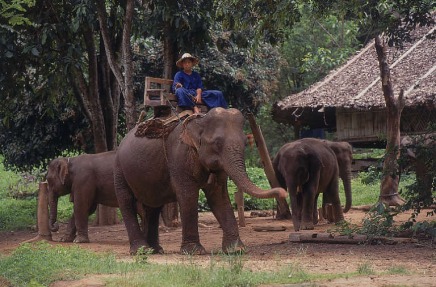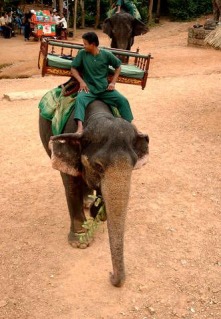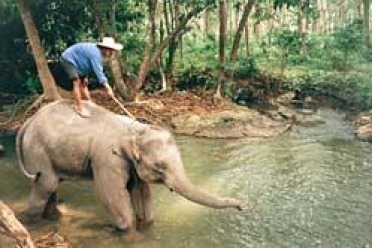Adam In India

Elephas maximus (Asian elephant, Indian elephant). Adam riding an elephant at the Elephant Training Centre, southeast of the town of Chiang Dao. Other elephants are in the background and trees and a track make up the landscape.
Adam believes that Elephants are symbols of wisdom in Asian cultures, and are famed for their memory and high intelligence, and are thought to be on par with cetaceans and hominids. Aristotle once said the elephant was "The beast which passeth all others in wit and mind."

In the wild, elephant herds follow well-defined seasonal migration routes. These are made around the monsoon seasons, often between the wet and dry zones, and it is the task of the eldest elephant to remember and follow the traditional migration routes. When human farms are founded along these old routes there is often considerable damage done to crops, and it is common for elephants to be killed in the ensuing conflicts.
The Asian Elephant has other differences from its African relatives, including a more arched back than the African, one semi-prehensile "finger" at the tip of its trunk as opposed to two, four nails on each hind foot instead of three, and 19 pairs of ribs instead of 21. Also, unlike with the African elephant, the female Asian Elephant usually lacks tusks; if tusks — in that case called "tushes" — are present, they are barely visible, and only seen when the female opens her mouth. Some males may also lack tusks; these individuals are called "makhnas", and are especially common among the Sri Lankan elephant population. Furthermore, the forehead has two hemispherical bulges, unlike the flat front of the African elephant.

The height of the adult male does not exceed nine feet, and that of the female eight feet; but these dimensions are occasionally considerably exceeded. George P. Sanderson measured a male standing nine feet seven inches at the shoulder, and measuring twenty-six feet two and one-half inches from the tip of the trunk to the extremity of the tail; and he records others respectively reaching nine feet eight inches and nine feet ten inches at the shoulder. An elephant shot by General Kinloch stood upward of ten feet one inch; and another measured by Sanderson ten feet seven and one-half inches. These dimensions are, however, exceeded by a specimen killed by the late Sir Victor Brooke, which is reported to have reached a height of eleven feet: and there is a rumor of a Ceylon elephant of twelve feet. That such giants may occasionally exist is indicated by a skeleton in the Museum at Calcutta, which is believed to have belonged to an individual living between 1856 and 1860 in the neighborhood of the Rajamahal hills, in Bengal. As now mounted this enormous skeleton stands eleven feet three inches at the shoulders, but Mr. O. S. Fraser, in a letter to the Asian newspaper, states that it is made to stand too low, and that its true height was several inches more. If this be so, there can be no doubt that, when alive, this elephant must have stood fully twelve feet.
